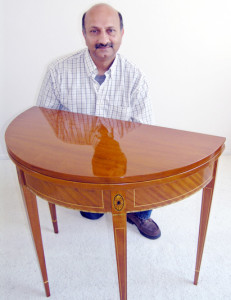Introduction
Many of us admire period furniture and similarly wish of owning a piece of our own. Unfortunately, these pieces are difficult to come by even though reproductions are available. Not only are the designs eye catching, but the finish accentuate the beauty of the design.
The shellac used in the past was available in a semi-raw form known as Seedlac. The dewaxed varieties that are used now a days were unknown some years back. The best that a furniture maker could do was to get rid of the wax by decanting the seedlac solution. Although painstaking, the final finish was well worth the wait. After all, the finish is the final word when it comes to the quality of the furniture!
Shellac was widely used till the late 60’s till Nitro Cellulose lacquer made its debut. Nitro Cellulose’s easy applicability and durable finish made it the most popular choice for finishers. Unfortunately, it did not produce the same Royal finish that shellac did. This Royal finish is the reason why shellac is still widely used by the few seasoned cabinet makers that exist today.
Many myths cloud the emergence and prominence of shellac after the appearance of nitro cellulose. One chief legend states shellac is not waterproof. Shellac, just as many other finishes, is not waterproof, however, it is quite water resistant. Shellac can easily withstand water for about 4 hours. Even if the surface is not wiped, the resulting faint white stain will still fade away as it dries. However, repairing shellac is extremely easy! As a matter of fact, shellac is far easier to repair than lacquer. Some other myths state that shellac cracks, fades, and turns yellow over time; most of which is untrue. Usually cracking occurs if the cabinet maker hasn’t sealed the inside of the piece. Since the outer surface of the furniture is sealed with shellac and the inside is bare, uneven surface expansion and contraction due to temperature causes the shellac to crack. Shellac never fades or yellow since it is UV resistant.
Why use shellac?
Shellac is 100% natural. It is produced by bugs that live in Northeastern India. Shellac is 100% non toxic and FDA approved. Therefore it is widely used in the cosmetic, drug and food industry. It is the only finish that should be used on children’s furniture due to its non toxicity!
Ever tried applying a coat of paint on a piece of Pine? Do you recall how it becomes blotchy because some areas of the Pine absorbs more paint than other areas? Well, next time apply a coat of shellac before painting. You will be surprised with the results. Shellac is a wonderful sealer. Apply it on every part of the furniture. It will protect it from temperature changes and will last for many years. The benefits of shellac are endless. You only have to try it to believe it.
We at ShellacFinishes want to bring this age old finish back from its glorious past, and into the present. After all these years on being in the business of using and selling shellac, I decided to formulate my own ready to use finish with shellac and synthetic resins. The aim was to produce a finish that looks and feels like shellac but is resistant to heat water and alcohol like any other finish.
ShellacFinishes proudly present Royal-Lac and Seal-Lac; our proprietary formula that is easy to apply, ready to use out of the jar and is resistant to heat, water and alcohol once cured. Watch my videos available under the ‘Videos’ menu to learn more about the product and how to apply it.
Here’s a video from my trip to India, where I explore the origins and manufacture of shellac.
As a user of shellac for many years, I am always fighting an uphill battle when it comes to convincing people that shellac can withstand the effects of moisture, heat and alcoholic drinks to a good extent. I have tried to bust this myth in my video; French Polish Like a Pro!, but it was simply gratifying to receive some comments from my customer Jacek in Poland.
June 2010: “In June I brushed brass letters on tombstone with shellac and they are shiny after many rainy days. Amazing.”
October 2010: “They are still shiny! Wow!
December 2010: ” So we have December and temperatures around 32F, rain all the time or snow – brass letters (45 degrees to the ground) are still very shiny! I’m waiting what will happen when temperature will go down to 15-20F.”
Jacek from Poland
